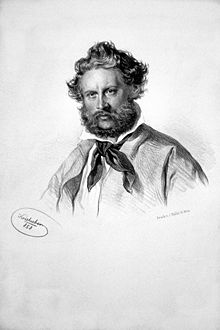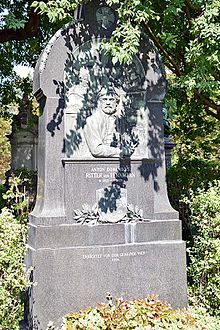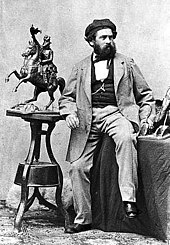Anton Dominik von Fernkorn

Anton Dominik Fernkorn , from May 22, 1860: Anton Dominik Ritter von Fernkorn (born March 17, 1813 in Erfurt , † November 16, 1878 in Vienna ) was a German-Austrian sculptor and caster . He is considered one of the most important masters of early historicism .
Life
education
After a partially self-taught training, Fernkorn studied at the Academy of Fine Arts in Munich with Johann Baptist Stiglmaier and Ludwig Schwanthaler . From around 1850 he was in Vienna, where from October 28, 1861 he used an old cannon foundry (today the Electrotechnical Institute building of the Vienna University of Technology in Gußhausstraße, which has been named since 1873) as a place of work ( picture foundry ) and worked with Johann Preleuthner . An artistic relationship also developed with Hanns Gasser , which is reflected in the relationship between numerous subjects .
sculpture
His best-known works are patriotic statues in Austria, especially the equestrian statues of Archduke Karl (1853-1859) and Prince Eugen (1860-1865) on Heldenplatz . He also created the Lion of Aspern , a reclining lion as a war memorial and a reminder of the victory over Napoleon in the Battle of Aspern . This sculpture is also on Heldenplatz - but on the one in Aspern (today part of Vienna- Donaustadt ).
The monument to Archduke Karl, based on a painting by Johann Peter Krafft , is a technical marvel in that the horse only stands on its hind legs. This feat could not be repeated with Prince Eugene: here the horse's tail touches the base.
illness
After several strokes Fernkorn was admitted to an official statement from May 17, 1867 due to national court raised madness under guardianship provided and in that of Maximilian Leidesdorf led private hospital for Gemüths- and nerve sick in Oberdöbling added. At the beginning of August of the year (allegedly) Fernkorn started a cure in the cold water sanatorium Sankt Radegund near Graz , but had to break it off after two weeks and return to Vienna for care.
According to a popular opinion at the time, Fernkorn's illness came from the disappointment that he was unable to repeat the technical achievement of the Archduke Karl monument or that even the most far-reaching plans could not be realized.
The equestrian statue of Prince Eugene was completed by Fernkorn's students. His pupil Franz Pönninger (1832–1906) and the technically and economically experienced ore caster Josef Röhlich (1836–1887), both directors of the company since 1866, successfully continued the art foundry workshop .
At the beginning of 1872 it was reported that Fernkorn had been in the state insane asylum for years . The treating primary physician (and later director of the institution) Moritz Gauster (1828-1896) stated that the patient had been transferred from care class I to class II at his own request with the aim of saving care class I, but without having experienced a worse position. (Fernkorn's financial position had been adversely affected by the economic effects of the German War of 1866.)
Fernkorn remained in clinical inpatient treatment, but was able to visit exhibitions from time to time accompanied by nursing staff, including in the rotunda and the Künstlerhaus ; The kk Hof Opera Theater , newly built on the Ringstrasse , also attracted the art caster's interest. On June 6, 1874, a (sales) exhibition of the work of the institution's patients was opened in the state insane asylum. Fernkorn, who in the years of his treatment could not be animated to graphic-creative occupation, was represented in the show by his favorite flower , an (expected) meeting with Emperor Franz Joseph I , who visited the exhibition on June 7th , he was denied for health reasons.

In August 1874, rumors grew that the artist was cured. The assumption that the discharge from the state insane asylum was imminent, however, did not come true. Instead, it was reported that Fernkorn suffered from megalomania, which the treating doctors believed to be incurable.
tomb
On May 18, 1905, the City of Vienna dedicated an honorary grave to the artist, who was already resting in the Vienna Central Cemetery, with the provision of a grave monument (later executed by Josef Beyer ) at the expense of the community (grave site: group 14 A, number 18). In 1880, Fernkorngasse in Vienna- Favoriten (10th district) was named after him.
meaning
Anton Dominik von Fernkorn is of eminent importance for the development of Austrian sculpture , his monumental works initiated an upswing in sculpture in Vienna.
Works (excerpt)
- Equestrian statue of Archduke Karl , 1853–1859, cast bronze , Vienna, Heldenplatz
- Equestrian statue of Prince Eugene of Savoy , 1860–1865, cast bronze, Vienna, Heldenplatz
- War memorial Lion of Aspern , 1850–1859, sandstone , Vienna, Asperner Heldenplatz
- Six colossal statues of German emperors in the vestibule of Speyer Cathedral
- Fountain group with St. George and the dragon, Vienna, house Strauchgasse 1, now in the "Reitersaal" of the Austrian control bank , Strauchgasse 3 (Reitersaal)
- Equestrian statuette of Prince Eugene of Savoy , around 1865, hollow bronze casting, Vienna, Army History Museum
- Equestrian statuette / monument model of Archduke Karl in the Battle of Aspern , 1847, bronze hollow casting, Army History Museum
- Statuette / memorial model The Lion of Aspern , 1855, plaster patinated, Army History Museum
- Figure group Bravery , 1863, bronze hollow casting, Army History Museum
- Figure group Mercy , 1863, bronze hollow casting, Army History Museum
- Figure group Treue , 1863, bronze hollow casting, Army History Museum
- Figure group Vaterlandsliebe , 1863, bronze hollow casting, Army History Museum
- Equestrian statuette / draft of the monument to the Archduke Karl Monument, 1863, bronze hollow casting, Army History Museum
- Equestrian monument to Ban Joseph Jelačić von Bužim , 1864–66, Zagreb / Agram (inauguration: December 17, 1866)
- Fragment of the original model of the Archduke Karl Monument, 1856, plaster patinated, Heeresgeschichtliches Museum
- Equestrian statuette Field Marshal Josef Wenzel Radetzky von Radetz , cast bronze, Ljubljana (Laibach), Novi Targ
- Siegfried statue in the vestibule of Postgasse 6, Vienna
gallery
Large statue of King Rudolf von Habsburg , in the Speyer Cathedral
Large statue of King Philip of Swabia , in the Speyer Cathedral
literature

- Constantin von Wurzbach : Fernkorn, Anton . In: Biographisches Lexikon des Kaiserthums Oesterreich . 4th part. Typogr.-literar.-artist publishing house. Establishment (L. C. Zamarski, C. Dittmarsch & Comp.), Vienna 1858, pp. 188–190 ( digitized version ).
- Eduard Leisching: Fernkorn, Dominik Anton Ritter von . In: Allgemeine Deutsche Biographie (ADB). Volume 48, Duncker & Humblot, Leipzig 1904, pp. 788-796.
- Fernkorn Anton Dominik von. In: Austrian Biographical Lexicon 1815–1950 (ÖBL). Volume 1, Verlag der Österreichischen Akademie der Wissenschaften, Vienna 1957, p. 303.
- Zdrawka Ebenstein: Fernkorn, Anton Dominik Ritter von. In: New German Biography (NDB). Volume 5, Duncker & Humblot, Berlin 1961, ISBN 3-428-00186-9 , p. 97 f. ( Digitized version ).
- Rudolf Benl: Anton Dominik Fernkorn (1813–1878): Origin, family and Erfurt youth of the ore caster; On the 125th anniversary of the artist's death . In: Mitteilungen des Verein für die Geschichte und Altertumskunde von Erfurt , Vol. 64 (2003), pp. 123–167, ISSN 0943-299X
- Ilse Krumpöck: The sculptures in the Army History Museum . Vienna 2004, pp. 41–44.
Web links
- Entry on Anton Dominik von Fernkorn in the Austria Forum (in the AEIOU Austria Lexicon )
- V .: In the Viennese casthouse. In: Wiener Abendpost. Supplement to Wiener Zeitung , No. 166/1874, July 23, 1874, p. 1325, center left. (Online at ANNO ). .
Individual evidence
- ^ Official part. In: Wiener Zeitung , No. 123/1860, May 23, 1860, p. 1, top center. (Online at ANNO ). .
- ↑ a b Ilse Krumpöck: Die Bildwerke im Heeresgeschichtliches Museum , p. 41.
- ↑ Announcements. (...) Curatel impositions. (…) 2. In: Official Gazette of the Wiener Zeitung and Central-Anzeiger für Handel und Gewerbe , No. 124/1867, May 25, 1867, p. 803 (unpaginated), column 2. (Online at ANNO ). .
- ↑ a b W. S — r .: Fernkorn. In: Local-Anzeiger der "Presse" , No. 8/1872 (XXV. Year), January 9, 1872, p. 9 (unpaginated) f. (Online at ANNO ). .
- ^ W (old) Krause : Röhlich, Josef (1836-1887), ore caster. In: Austrian Biographical Lexicon 1815–1950 (ÖBL). Volume 9, Verlag der Österreichischen Akademie der Wissenschaften, Vienna 1988, ISBN 3-7001-1483-4 , p. 201. - Josef Roehlich, director of the kk art ore foundry etc. in Vienna. In: Wiener Salonblatt , No. 18/1875 (VI. Volume), May 1, 1875, p. 3 ff. (Online at ANNO ). .
- ^ Vienna, January 5th. (...) The end of an artist. In: Local-Anzeiger der "Presse" , No. 6/1872 (XXV. Year), January 6, 1872, p. 14, top left. (Online at ANNO ). .
- ↑ Little Chronicle. (...) Fernkorn. In: Die Presse , No. 7/1872 (XXV. Year), January 8, 1872, p. 4, bottom center. (Online at ANNO ). .
- ↑ Daily news. (...) The opening of the exhibition in the insane asylum. In: Deutsche Zeitung , Abendblatt, No. 871/1874 (XXV. Volume), June 6, 1874, p. 3, bottom center. (Online at ANNO ). .
- ↑ The visit of the emperor to the asylum. In: Die Presse , No. 156/1874 (XXVII. Year), June 8, 1874, p. 4 below. (Online at ANNO ). .
- ↑ Daily news. (...) Knight of Fernkorn not healed. In: Morgen-Post , No. 233/1874 (XXIV. Volume), August 26, 1874, p. 3 (unpaginated), middle. (Online at ANNO ). .
- ↑ Hedwig Abraham (Red.): Anton Ritter von Fernkorn . In: viennatouristguide.at , accessed on December 10, 2015.
Remarks
- ↑ According to an announcement of the Neue Freie Presse of August 13, 1867, correcting the Vienna correspondence , Fernkorn had been in the private clinic in Oberdöbling for over six months and was on the mend. - See: Little Chronicle. (...) Personal news. In: Neue Freie Presse , Morgenblatt, No. 1060/1867, August 14, 1867, p. 5, bottom center. (Online at ANNO ). .
-
↑ The imperial ore foundry was visited on October 4, 1871 by Dom Pedro II , Emperor of Brazil.
The charmingly furnished Fernkorn's artist workshop was assigned (at state expense) by Emperor Franz Joseph I himself to Hans Makart (1840–1884), who was called to Vienna from Munich . - See: Hans Markart in his studio. In: Illustrirtes Wiener Extrablatt , No. 88/1875 (Volume IV), March 30, 1875, p. 1. (Online at ANNO ). . - ↑ (...) It really cannot be denied that the main works of our Viennese master Fernkorn are in Agram. (...) . - See: Otto Groß: Feuilleton. From the south and east. Travel letters from Dr. Otto Gross. XXI. Agram. In: Wiener Zeitung , No. 1/1869, January 1, 1869, p. 9, center left. (Online at ANNO ). .
| personal data | |
|---|---|
| SURNAME | Fernkorn, Anton Dominik von |
| ALTERNATIVE NAMES | Fernkorn, Anton Dominik Ritter von |
| BRIEF DESCRIPTION | German-Austrian sculptor and sculptor |
| DATE OF BIRTH | March 17, 1813 |
| PLACE OF BIRTH | Erfurt |
| DATE OF DEATH | November 16, 1878 |
| Place of death | Vienna |







